International Marketing Techniques [Webinar]

We brought together our experts in International Marketing to talk about the different techniques that promote the internationalization of a business. From analyzing the impact on new markets, as you will detail Alberto Cañas, Marketing Director at Novicell, until we delve into search engine positioning in different countries, hand in hand with Javiera Lillo, SEO Team Lead SEO and reap the benefits of the exciting world of international paid advertising with Jonathan Terreni, our SEM Team Lead.
So, do you dare to take a look at the recording of the webinar? Or if you prefer, we've summarized the session so you don't miss out on best practices and advice from our experts.
Marketing tools to internationalize your business
The session begins with Alberto Cañas, who explains how to use digital marketing tools to carry out a market study and determine in which countries it is feasible to introduce our products or services.
The use of digital marketing tools is not only limited to the promotion or distribution of content, but it is also valuable for conducting market research. When considering the internationalization of a business, it is essential to determine in which countries and with which products or services it makes the most sense to expand. Some products may be more suitable in certain markets than in others.
Instead of opting for a traditional market research approach, which can be costly and take months, we can take a more agile and digital approach to obtain relevant information and to test the concept of internationalization efficiently.

In this sense, we can take advantage of the tools provided by Google, many of which are free, to obtain a hypothesis about the viability of our products or services in other countries.
Think with Google
This platform share information on digital evolution in different markets and consumer studies in different countries. It is a compilation of market research at our fingertips and free of charge.
Market Finder
Inside Think with Google, you will find the Market Finder, which, when you enter your URL and categories related to your business, suggests markets that might be suitable for internationalization.
Google Public Data
A tool that view data from public entities such as, for example: Eurostar or the World Bank. These data are presented graphically for understand macroeconomic trends, such as unemployment in different regions of a country, which can influence the internationalization strategy.
Google Trends
It offers Information on search trends in different countries for various products or services. While not the only basis for decisions, it provides clues as to the possible direction of expansion.
Google Analytics
Through this tool, we can analyze How our website impacts different countries, which pages generate traffic and where our presence makes sense.
Google Search Console
It allows understand what terms or concepts are searched for in different countries and how our website is positioned.
Keyword Planner
While this tool is within Google Ads, it can also be used to understand the competition of certain products or services in different countries, which helps to decide which markets it is most viable to enter.
In addition to these digital tools, a qualitative search browsing blogs, articles, and other resources from specific countries is essential for a deeper understanding.
It is important to mention that the choice of tools varies depending on the target market. For example, the strategy for internationalization in China would be different and Google would not be the tool to use.
SEO techniques to internationalize your business
Javiera, SEO Team Lead at Novicell, provides us with a complete vision of how organic positioning strategies can boost traffic and business results.
Within the digital solutions to take your business to the international arena, SEO plays an essential role. Let's start by addressing two of the most common mistakes companies face when trying to implement international SEO.
- An incorrect international web structure. Often, we want to target multiple markets without having thoroughly researched the audience we want to reach.
- The incorrect use of the HREFLANG attribute. By not localizing the content and translating it directly, you are not linking the language versions and this could be penalized.
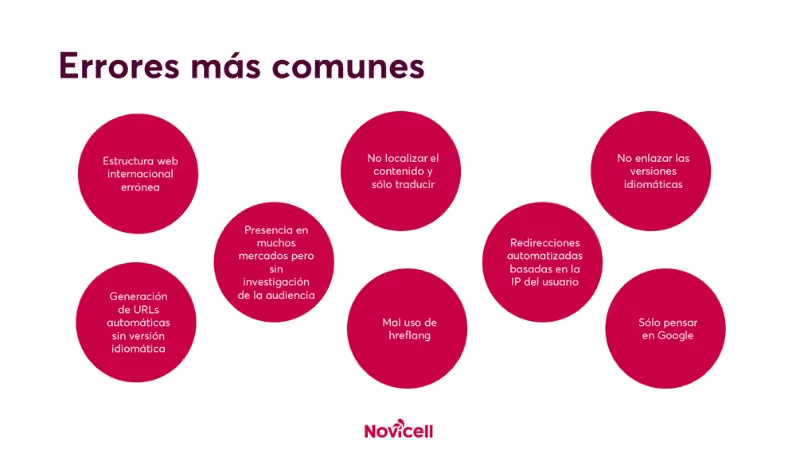
Now, let's focus on how to avoid these mistakes when internationalizing your business through SEO strategies.
Let's go back to basics and consider SEO as if it were the human body. Technical SEO is the most important foundation of a website. Let's imagine this as the skeleton or spine of the body. On-page SEO encompasses everything that nourishes this body, that is, the organs, muscles and veins. Subsequently, local SEO is associated with the place of birth.
Technical SEO in Business Internationalization
In the area of Technical SEO, we work with three fundamental pillars per tackling internationalization: the web structure, the URLs and the HREFLANG attribute. Let's look at each of these elements separately.
Web structure
The first pillar is the web structure, there are different structures, let's analyze the pros and cons of each one:
- Domain “example.es” or “example.eu”: allows us to clearly segment by extension. However, this may require more effort for each of the domains, since they are considered separate entities.
- Idiomatic subfolder “example.com/es”: offers great authority, since all languages are associated with a subdomain, improving the domain's authority. However, it's a much deeper website, since each language folder has other pages and folders.
- Subdomain “es.example.com”: provides the ability to use servers in different locations, but this may require additional technical resources.
Which is the right choice? It will depend on the investment, time and resources available. Here are some questions that can help you determine which web structure is more suitable for you:
- In how many countries do we want to have a presence? Whether they are many or few, this can guide our choice.
- How many resources do we have available for website development? How are we resolving this issue?
- How does the competition perform? If they're doing well, it's useful to look at how they're doing it.
The HREFLANG Attribute
The second pillar, the HREFLANG attribute, is an HTML tag that helps us direct the language and region that a page focuses on. We distinguish between multilingualism and multi-regionality.

- Multilingualism: for example, in Barcelona, two languages are spoken: Catalan and Spanish. Therefore, these languages must be reflected in the HTML code.
- Multi-regional: involves several languages, but in different countries. For example, Spanish is spoken in Spain, Chile and Argentina. This should also be reflected in the HTML code.
It is crucial to properly implement these HREFLANG tags, and there are tools to verify their correct implementation.
Some good practices include:
- Use valid regional and language codes (languages: ISO 639-1, countries: ISO 3166-1)
- Include the Hreflang only when the language version is available
- Link the language versions
- Set a default international version and don't redirect by IP
- In addition to the Hreflang, use the meta Lang (<html lang = “language_code">)
- Use absolute URLs
URLs
The third pillar in technical SEO focuses on URLs. Often we see URLs that stay the same, whose content is dynamic; this is not appropriate. Each piece of content must have its own unique URL so that Google can index and rank correctly.
Avoid errors in your URLs with these best practices:
- URLs must be unique
- Use SEO-friendly and geolocation friendly URLs
- Content should not change dynamically under the same URL
- The URL must be in the language the user is visiting
- Don't use parameters to identify the language
- Support yourself by creating sitemap.xml for each language version
- For large websites with multiple languages, use XML sitemaps for each language version.
- If the site is smaller and uses idiomatic domains, an XML sitemap will suffice.
On-Page SEO for the Internationalization of Your Business
After technical SEO, we delve into the On-page SEO. Here, we'll focus on two key aspects: localization and content strategy.
Localization
Often, we simply translate a keyword when addressing an international audience. However, when tackling global optimization, it's essential to adjust keywords to each local audience. This can lead to a greater impact, reaching a greater number of potential users in different markets.
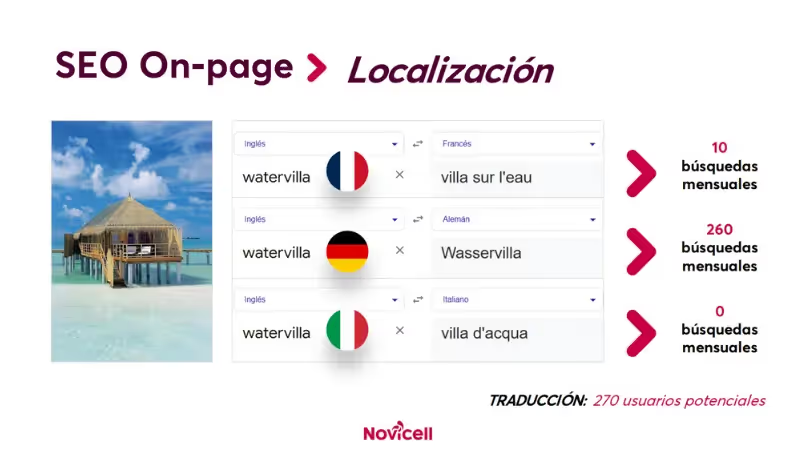
Some good practices include:
- Don't translate the content, you must localize it
- Do a study of your audience to learn about their behaviors
- Analyze what words the competition is using
- Localize all the content of your website (URLs, titles, metadata, navigation, etc.)
- It has native SEO specialists for localization and optimization
- Don't forget about images with text
Content Strategy
To address content strategy, let's consider the keyword example “aerothermy”. Let's look at your search interest in different countries, such as Mexico and Spain. PICTURE
This shows that interest may vary by region. Which leads us to wonder if Is it valuable to invest in specific markets.
An important aspect of content strategy is seasonality. Trends and demands vary by location. For example, the demand for air conditioners in Chile increases during the summer months of November and December, while in Spain, demand grows between June and August.
Some good practices include:
- Analyze the interests of the audience in each location
- Plan and adapt the content for each country, considering cultural and seasonal differences
- Keep content up to date in all languages, avoiding duplication and ensuring consistency
- Consider whether users in each country use search platforms other than Google
- Assess if legal restrictions may affect strategy in certain countries
- Design a 360 marketing strategy that goes beyond SEO, such as SEM campaigns
Local SEO for the Internationalization of Your Business
Finally, let's address the Local SEO. Although we're talking about internationalization, it's essential to understand how local SEO works to be successful in new markets. In this section, we explore local competitors and local digital presence.
Local Competitors
When entering a new market, it's crucial to understand the local competition. Let's research who they are, their domain authority, the keywords they prioritize, and the backlinks they receive. This will provide us with a deep understanding of our competence.
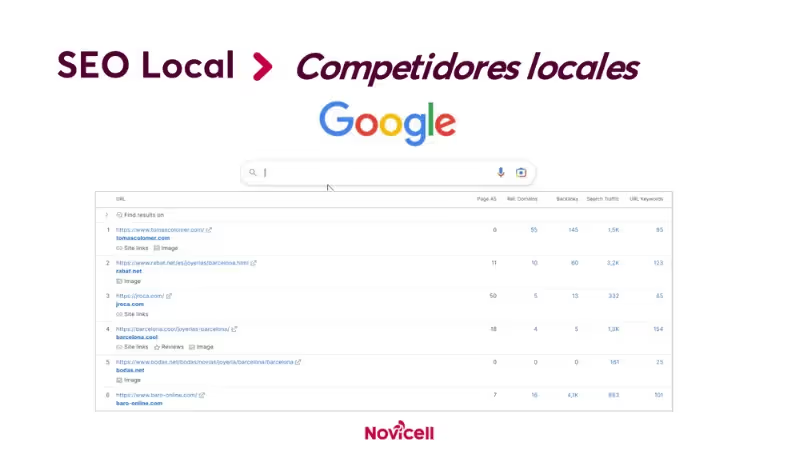
Some good practices include:
- Identify the main competitors in each location.
- Analyze search results for your business in those areas.
- Discover your competitors' keyword strategy and how they implement them.
- Observe the architecture and navigation of your websites.
Local Digital Presence
When entering a new market, it's critical create a local digital presence. This includes building local links that demonstrate your relevance in search engines. This way, you will be able to get your business recognized in the new location.

Some good practices include:
- Build local presence through local links
- Host your website on a local IP, if possible
- Work your local files at GMB, if necessary
- Analyze how your audience searches and behaves. Do they use Google or another engine/platform?
- What appears when we search for “our service + the city”?
- Are there legal restrictions in the countries in which we want to position ourselves?
- 360º marketing strategy to gain visibility and reputation, not only does SEO exist
- Design a comprehensive marketing strategy that includes SEO and SEM to achieve full visibility
Thanks to these technical, on-page and local SEO strategies and practices, you can optimize your international expansion and improve your visibility in foreign markets.
SEM techniques to internationalize your business
Jonathan Terreni, SEM Team Lead at Novicell, shares valuable steps and tips on how to use paid advertising to internationalize a business, as well as strategies for the lead capture in B2B and B2C business models.

Let's start by exploring the three essential steps for developing an international payment campaign strategy, regardless of the type of business or target countries:
Investigation
Use Google Analytics to understand the audience that visits your website and that you could impact globally. It is not enough to know the origin of the traffic; it is essential to detail the audience we want to target with paid advertising. Segmenting the audience by region, age, device and other criteria will allow us to effectively impact our campaigns.
Market Analysis
To enter new markets, we must analyze the trends and behaviors of each country. Google Trends helps us understand searches and trends in terms of keywords. This allows us to anticipate search peaks. Planning campaigns prior to these peaks can increase recognition and gain a competitive advantage.
Competence Study
It's crucial to understand the competition in terms of paid advertising. Using tools such as Semrush allows us to analyze the traffic strategies of our competitors and understand their investment moments. We can also evaluate if we are competing for the same keywords and if it is profitable to compete for them.
How to guide the user to the conversion with SEM
When having the objective of selling and obtaining leads, it is essential to understand, especially when entering a new market, that we must go through a phase of “awareness”. In this sense, it is necessary to carry out branding campaigns with specific actions to achieve recognition by the audience. Generating interest involves building trust from the start. When entering an unknown market, it's essential to communicate our added value.
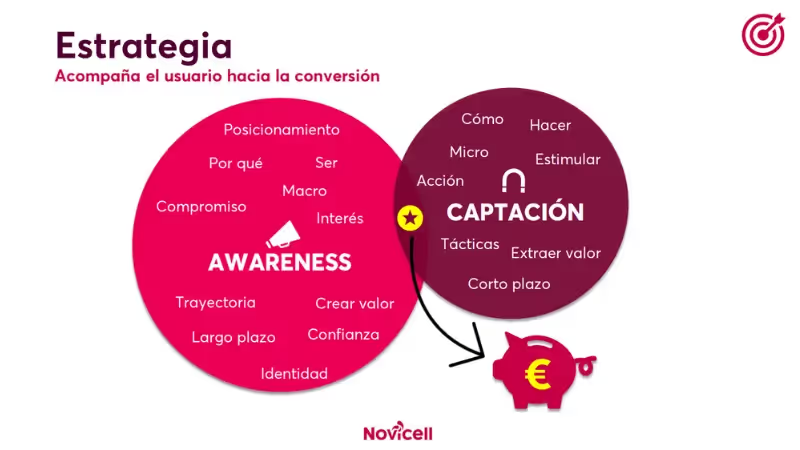
This process is then linked to uptake. Initially, it focused on 60% on branding and 40% on recruitment actions, gradually adjusting the strategy. To eventually enter a recruitment phase where all the previous actions carried out in relation to branding are finalized, using tactics that will help us extract true value.
SEM Tips for Lead Capture
In the B2B and B2C context, lead capture is essential to drive business growth. Here are a few specific strategies and tips for both models.
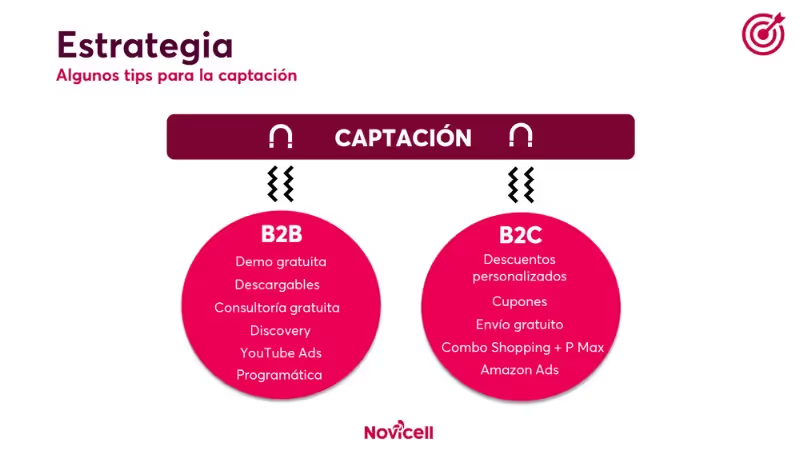
SEM Tips for B2B
- Offer something of value to the user before requesting their contact, such as a free demo, a success story or a market report.
- Collaborate with the sales team to understand user interaction during the sales phase.
- Use branding tactics, such as Discovery campaigns and YouTube ads
- Examine platforms such as Google Ads, LinkedIn Ads and Meta Ads to segment and reach the target audience.
SEM Tips for B2C
- Offer personalized discounts, coupons or incentives to retain users and attract new customers.
- Explore platforms such as Amazon Ads for high return on investment campaigns.
- Use a combination of Shopping Ads and Performance Max in Google Ads to maximize conversions.
- Segment profitable products and use return on investment (ROAS) strategies to optimize campaigns.
Conclusion: The importance of a joint strategy
The internationalization of a business through SEM strategies requires a deep understanding of the target audience, market trends and competition. By combining branding and recruitment tactics, we can achieve sustainable and effective growth in international markets. Remember that SEO and SEM work together to create a strong presence both in terms of organic search and paid advertising.
Both the SEO such as SEM are essential when internationalizing a business. While SEM campaigns can provide immediate results, we must not forget that they also need time to optimize and obtain valuable data. The ideal strategy involves both SEO and SEM, encompassing both the organic and paid aspects.
If you need help with your International Marketing Strategy, do not hesitate to contact us, we will advise you based on the needs of your business to successfully achieve your business objectives.
Cómo podemos ayudarte
Consulta los servicios con los que te ayudaremos a conseguir tus objetivos digitales.
.avif)